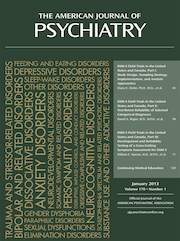Suicidal behavior is a major public health concern worldwide for which culturally appropriate interventions are desperately needed. Almost 3 years ago, I lost two individuals in my social network across two continents to suicide in a space of 6 months. I was devastated to say the least. I accepted to review this book because I have many unanswered questions about suicide, both from the perspective of a psychiatrist/researcher and that of one who has been personally affected.
In this book, Matthew K. Nock and colleagues add to the growing scientific literature on global mental health problems. Their book offers a fresh perspective on the epidemiology of nonlethal suicidal behavior by presenting data from more than 100,000 study participants, from 21 countries, who participated in the World Health Organization World Mental Health Survey Initiative. The book is organized into five sections. In the introductory section (chapters 1–3), the authors review the global burden of suicidal behavior and the methods of the World Mental Health survey and provide an updated literature review on what is already known about suicidal behavior across the globe. The second section (chapters 2 and 4) focuses on two cross-sectional studies on the prevalence and onset of suicidal behavior, transitions in the behavior, and persistence of the behavior over time. The authors describe a number of novel findings from these two studies. Most remarkable was the finding that “in all countries, the highest risk period for transitioning from ideation to plan or to attempt occurs during the first year after the onset of ideation (p. 73).” For clinicians, this emphasizes the importance of not shying away from asking about suicide ideation or plans because the period within which we must take action to prevent a suicide act is quite limited.
Sections 3–4 (chapters 6–14) are devoted to cross-sectional studies on a wide range of both short- and long-term risk factors for suicidal behavior and treatment of suicidal persons. Although these studies confirm much of what is already known about risk factors for suicide, they also provide new findings. What is unique in these studies is that they further demonstrate the extent to which each risk factor is associated with the onset, transition, and persistence of suicidal behavior over time. Further, they provide risk-factor indices that clinicians can use to identify those at high risk for suicide attempt. These cross-sectional studies are well written with detailed analyses and descriptions of study findings.
In Chapter 14, which describes findings regarding the treatment of suicidal behavior, the authors report that “only 39% of suicidal respondents received treatment in the past year, with consistently lower proportions having received treatment in low- (17%) and middle-income countries (28%) than in high-income countries (56%) (p. 208).” Indeed, the low numbers of suicidal individuals receiving treatment in low-income countries is not surprising given emerging data from some low-income countries indicating that the act of suicide is not only regarded as dangerous, criminal behavior but is also not discussed by affected families and the community (
1,
2). In the concluding section, the authors take the reader through a series of further analyses that could provide deeper insight into the mechanisms through which various factors increase the risk of suicidal behavior.
Although this innovative book has invaluable information for graduate students, scientists, clinicians, and policy makers, some limitations should be noted. Suicide: Global Perspectives From the WHO World Mental Health Surveys does not provide any information to enhance our knowledge of what suicidal behavior means in different cultural contexts. Although the World Mental Health Consortium made efforts to translate its assessment tools from the language the instrument was originally developed into the traditional dialect of a given population, this book falls short in reporting on the local concepts of suicidal behavior in the different cultural settings and the steps taken to make the assessment tools culturally appropriate in any given population. Understanding local concepts of suicidal behavior is a necessary first step in designing further global epidemiological, intervention, and prevention studies on suicidal behavior that would guide the development and implementation of culturally appropriate suicide prevention programs.
Further, the exclusion of many studies from low-income countries (
3–
10) in the updated literature review of suicidal behavior in chapter 2 coupled with the gross under-representation of low-income countries in the World Mental Health Survey Initiative suggests that the data presented do not truly represent a global perspective of suicidal behavior.
Despite these limitations and many others that are well acknowledged by the authors throughout the text, this book provides invaluable information that has potential to inform the design and implementation of intervention and preventive strategies for suicidal behavior.

